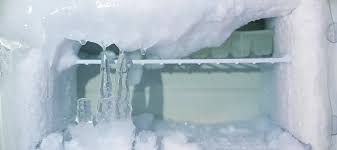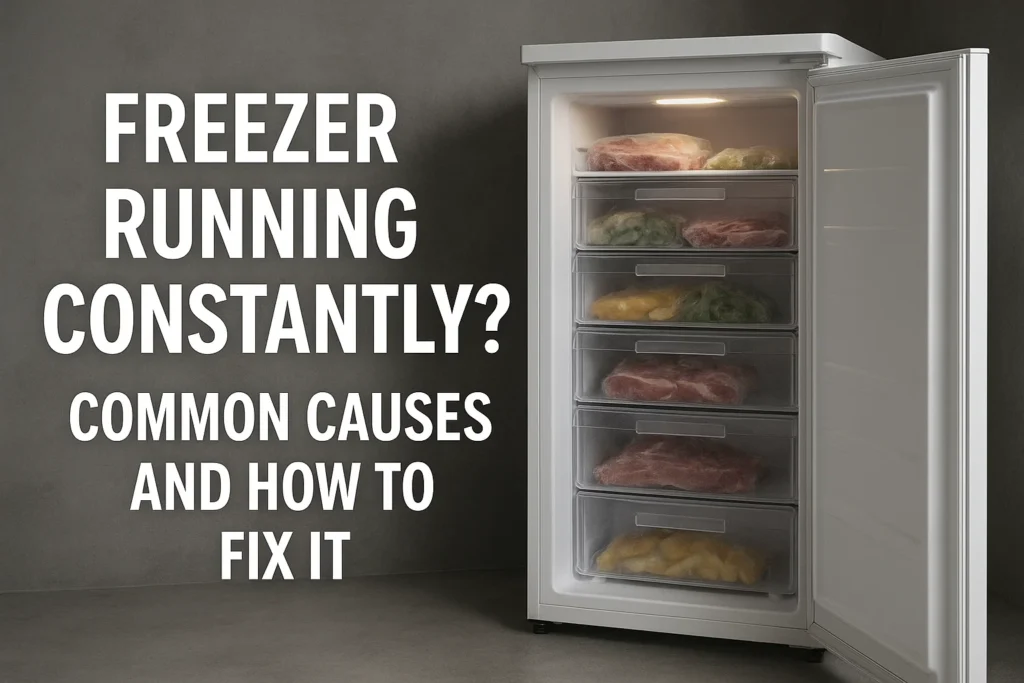When a freezer seems to run non-stop, it’s natural to be concerned. The compressor hums continuously, fans never stop, and there’s no audible pause in operation. While this behavior isn’t always a problem, it can be a sign of inefficiency or a developing fault.
If you’re in the New York area and want a quick, professional diagnosis, you can schedule a freezer repair here.
Why Continuous Running Is a Problem
- Increased energy bills — A constantly running freezer consumes significantly more electricity.
- Component wear — Compressors, fans, and circuits experience extra stress, reducing their lifespan.
- Ineffective cooling — In some cases, despite running all the time, the freezer may still fail to maintain temperature.
- System failure risk — Continuous running can eventually lead to full breakdowns if underlying issues aren’t addressed.
When It’s “Normal” vs When It Indicates a Fault
| Situation | Running More Often is Normal | Abnormal Continuous Running |
|---|---|---|
| Hot summer conditions | ✔️ | — |
| Frequent door openings | ✔️ | — |
| Large quantity of warm food added | ✔️ | — |
| Constant compressor activity, no cycling | — | ✔️ |
| Ice buildup or temperature rising | — | ✔️ |
| Loud noises or unexpected energy usage | — | ✔️ |
Understanding these differences can help you determine whether to act or observe.
Normal Conditions vs Abnormal Behavior
When It’s Normal for the Freezer to Run More Often
- High room temperature — During summer, or if the freezer is near a heat source, longer run times are expected.
- Door opened frequently — Warm air constantly entering forces the unit to work harder.
- Recent loading of unfrozen food — Large volumes of warm items require extended cooling cycles.
Signs That “Running All the Time” Is Abnormal
- Compressor never shuts off, even with stable internal temperature.
- Frost building up inside, or temperatures are rising instead of staying low.
- Unusual sounds, or a sudden increase in your electricity bill.
- Freezers showing these signs may require repair — get help from a technician here.
Common Causes of a Freezer Running Constantly
Dirty or Clogged Condenser Coils
Dust and debris reduce heat dissipation, making the freezer inefficient. Coils located at the back or underneath the unit should be cleaned every 6–12 months.

Faulty Temperature Control / Thermostat
When the thermostat sticks or misreads temperature, it may fail to shut off the compressor. This causes continuous cooling even when unnecessary.
Defrost System Malfunction (Timer, Thermostat, Heater)
A failed defrost system leads to frost buildup on evaporator coils, restricting airflow. This forces the freezer to overwork. Key causes include:
- Stuck defrost timer
- Faulty defrost thermostat
- Broken heater element
Faulty Evaporator Fan or Condenser Fan
If either fan stops working or is obstructed, air circulation suffers, and the compressor compensates by running constantly.
Door Gasket or Seal Issues
Even a small crack in the door seal allows warm air to seep in. The freezer then has to work harder, running longer to maintain temperature.
Overloading or Blocking Vents
Tightly packed items or blocked vents prevent proper airflow, making cooling uneven and forcing the unit to run continuously.
Refrigerant Leak or Sealed System Problem
If there’s a refrigerant leak or sealed system damage, the cooling capacity drops. The compressor will run constantly but still fail to cool effectively. These issues often require professional service.
Control Board or Electronics Malfunction
The control board may send a continuous “run” signal due to logic errors or misinterpreted sensor inputs. If all mechanical components seem fine, electronics may be to blame.
Diagnosing the Problem — Step by Step
1. Safety First — Unplug and Prepare
Always turn off power before inspecting. Move the freezer away from the wall if needed.
2. Perform Visual Checks
- Inspect the door seal using the paper test (trap a sheet of paper in the door — if it slips easily, the seal may be worn).
- Check coils and fans for dust or obstruction.
3. Observe Fan and Compressor Behavior
- Are the fans spinning?
- Is the compressor hot or buzzing?
- Does it ever shut off?
4. Test Temperature Control
- Turn the thermostat dial and listen for a click.
- Use a multimeter to check for continuity.
5. Inspect the Defrost System
- Manually advance the defrost timer if accessible.
- Check the defrost heater and thermostat for continuity.
- Look for heavy frost on evaporator coils.
6. Evaluate the Fans and Wiring
- Spin fan blades manually to check for resistance.
- Inspect wiring harnesses for looseness or corrosion.
7. Check for Sealed System Issues
- Signs include a hissing sound, frost in odd places, or oily residue near the tubing.
- These typically require certified repair — you can book a freezer technician in NYC.
8. Examine Control Board / Electronics
If all other components seem functional, a faulty control board could be stuck in cooling mode.
Possible Solutions & Repair Steps
Cleaning the Condenser Coils

Use a coil cleaning brush or vacuum cleaner to remove debris. This simple step can significantly improve performance.
Replacing the Thermostat or Temperature Control
Choose the correct replacement, follow manufacturer guidelines, and double-check connections.
Repairing or Replacing Defrost System Components
Swap out a stuck defrost timer, faulty thermostat, or broken heater after confirming the diagnosis.
Fan Repairs
Ensure blades are unobstructed. Replace fan motors if they’re not spinning freely or are noisy.
Fixing the Door Seal
Clean the gasket, reseat it properly, or install a new one if it’s worn or cracked.
Improving Interior Airflow
Avoid overloading. Leave space between items and keep air vents clear.
Calling a Professional for Sealed System Repairs
Tasks involving refrigerant or compressors should only be handled by licensed technicians.
Replacing Control Electronics
If all else fails, replacing the control board may be the solution. Use a board that matches your freezer model.
Preventive Maintenance to Avoid Constant Running
- Clean condenser coils every 6 months.
- Inspect door seals regularly for wear or gaps.
- Don’t overload the freezer.
- Maintain good airflow around and inside the unit.
- Monitor performance — unusual sounds or temperatures can be early warning signs.
Frequently Asked Questions (FAQ)
Is it ever okay for a freezer to run continuously?
Yes, temporarily — such as during hot days, after adding warm items, or when the door is opened often.
Can continuous running damage the freezer?
Yes. It causes extra wear and can lead to early failure of key parts like the compressor or fans.
Does constant operation increase electricity usage?
Definitely. It can raise your power bill significantly if the freezer isn’t cycling properly.
When should I replace rather than repair?
If major components like the sealed system fail and repair costs approach 50% of a new freezer’s price, replacement is usually the better option.
Can I fix these issues myself?
You can handle basics like cleaning coils, checking seals, and testing thermostats. For sealed system issues or electronic faults, calling a technician is recommended.
Need expert help? Get professional, fast, and reliable freezer repair in New York City with same-day service available.
